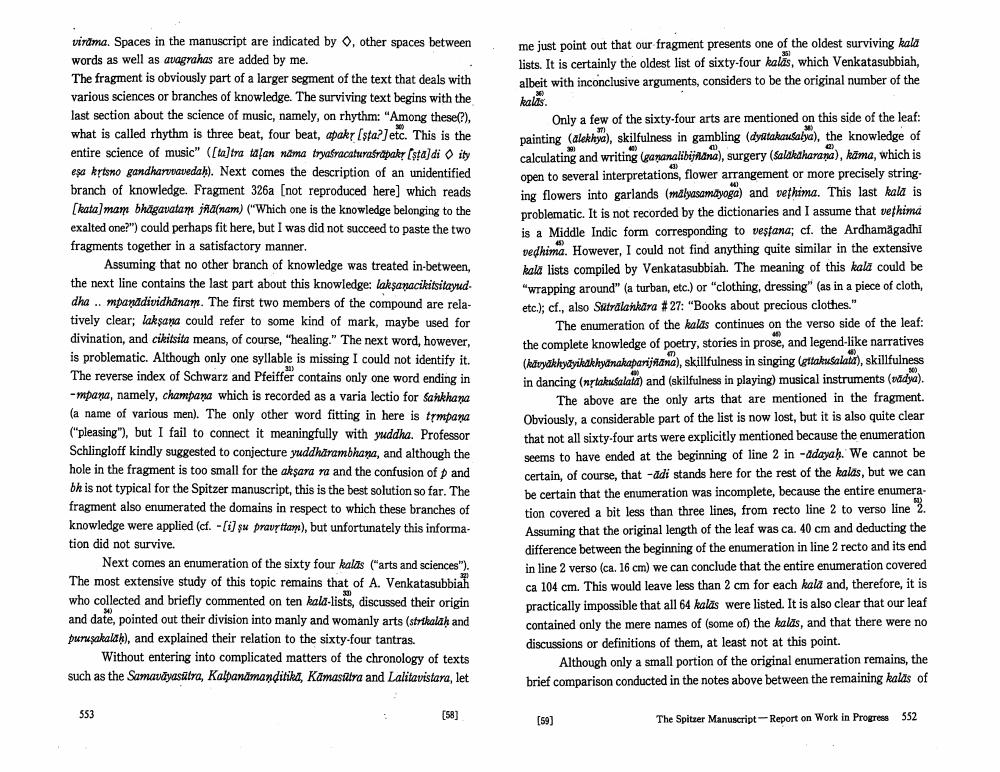Book Title: Spitzer Manuscript Report On Work In Progress Author(s): Eli Franco Publisher: Eli Franco View full book textPage 6
________________ me just point out that our fragment presents one of the oldest surviving kala lists. It is certainly the oldest list of sixty-four kalās, which Venkatasubbiah, albeit with inconclusive arguments, considers to be the original number of the virama. Spaces in the manuscript are indicated by other spaces between words as well as avagrahas are added by me. The fragment is obviously part of a larger segment of the text that deals with various sciences or branches of knowledge. The surviving text begins with the last section about the science of music, namely, on rhythm: "Among these(?). what is called rhythm is three beat, four beat, apaky [sta?) etc. This is the entire science of music" ([ta]tra talan nama tryafracatura rapaky Estaldi ity esa krisno gandharvnavedah). Next comes the description of an unidentified branch of knowledge. Fragment 326a (not reproduced here) which reads (kata] mam bhagatatan jnanam) ("Which one is the knowledge belonging to the exalted one?") could perhaps fit here, but I was did not succeed to paste the two fragments together in a satisfactory manner. Assuming that no other branch of knowledge was treated in-between, the next line contains the last part about this knowledge: laksanacikitsitayud. dhe .. mpanddividhanam. The first two members of the compound are relatively clear; laksana could refer to some kind of mark, maybe used for divination, and cikitsita means, of course, "healing." The next word, however, is problematic. Although only one syllable is missing I could not identify it. The reverse index of Schwarz and Pfeiffer contains only one word ending in -mpana, namely, champana which is recorded as a varia lectio for Sahkhana (a name of various men). The only other word fitting in here is tympana ("pleasing"), but I fail to connect it meaningfully with yuddha. Professor Schlingloff kindly suggested to conjecture yuddharambham, and although the hole in the fragment is too small for the aksara ra and the confusion of and bh is not typical for the Spitzer manuscript, this is the best solution so far. The fragment also enumerated the domains in respect to which these branches of knowledge were applied (cf. -[i su pravyttant), but unfortunately this information did not survive. Next comes an enumeration of the sixty four kalas ("arts and sciences"). The most extensive study of this topic remains that of A. Venkatasubbiah who collected and briefly commented on ten kala-lists, discussed their origin and date, pointed out their division into manly and womanly arts (strtkalah and purusakala), and explained their relation to the sixty-four tantras. Without entering into complicated matters of the chronology of texts such as the Samatīvasitra, Kalpanāmanditika, Kamasutra and Lalitavistara, let Only a few of the sixty-four arts are mentioned on this side of the leaf: painting (alekhya), skilfulness in gambling (dyatakausalya), the knowledge of calculating and writing (ananalibijnana), surgery (Salakaharana), käma, which is open to several interpretations, flower arrangement or more precisely string. ing flowers into garlands (malyasamayoga) and vethima. This last kala is problematic. It is not recorded by the dictionaries and I assume that wethima is a Middle Indic form corresponding to vestana; cf. the Ardhamagadhi vedhima. However, I could not find anything quite similar in the extensive kala lista compiled by Venkatasubbiah. The meaning of this kala could be "wrapping around" (a turban, etc.) or "clothing, dressing" (as in a piece of cloth, etc.); cf., also Sutralankara #27: "Books about precious clothes." The enumeration of the kalas continues on the verso side of the leaf: the complete knowledge of poetry, stories in prose, and legend-like narratives (kivyakhyzykakhyanakaparijnana), skillfulness in singing (ettakusalatd), skillfulness in dancing (nytakusala) and (skilfulness in playing) musical instruments (vadya). The above are the only arts that are mentioned in the fragment. Obviously, a considerable part of the list is now lost, but it is also quite clear that not all sixty.four arts were explicitly mentioned because the enumeration seems to have ended at the beginning of line 2 in -adayah. We cannot be certain, of course, that -adi stands here for the rest of the kalas, but we can be certain that the enumeration was incomplete, because the entire enumeration covered a bit less than three lines, from recto line 2 to verso line 2 Assuming that the original length of the leaf was ca. 40 cm and deducting the difference between the beginning of the enumeration in line 2 recto and its end in line 2 verso (ca. 16 cm) we can conclude that the entire enumeration covered ca 104 cm. This would leave less than 2 cm for each kala and, therefore, it is practically impossible that all 64 kalas were listed. It is also clear that our leaf contained only the mere names of (some of the kalas, and that there were no discussions or definitions of them, at least not at this point. Although only a small portion of the original enumeration remains, the brief comparison conducted in the notes above between the remaining kalas of 553 [58] [59] The Spitzer Manuscript - Report on Work in Progress 552Page Navigation
1 ... 4 5 6 7 8 9 10
